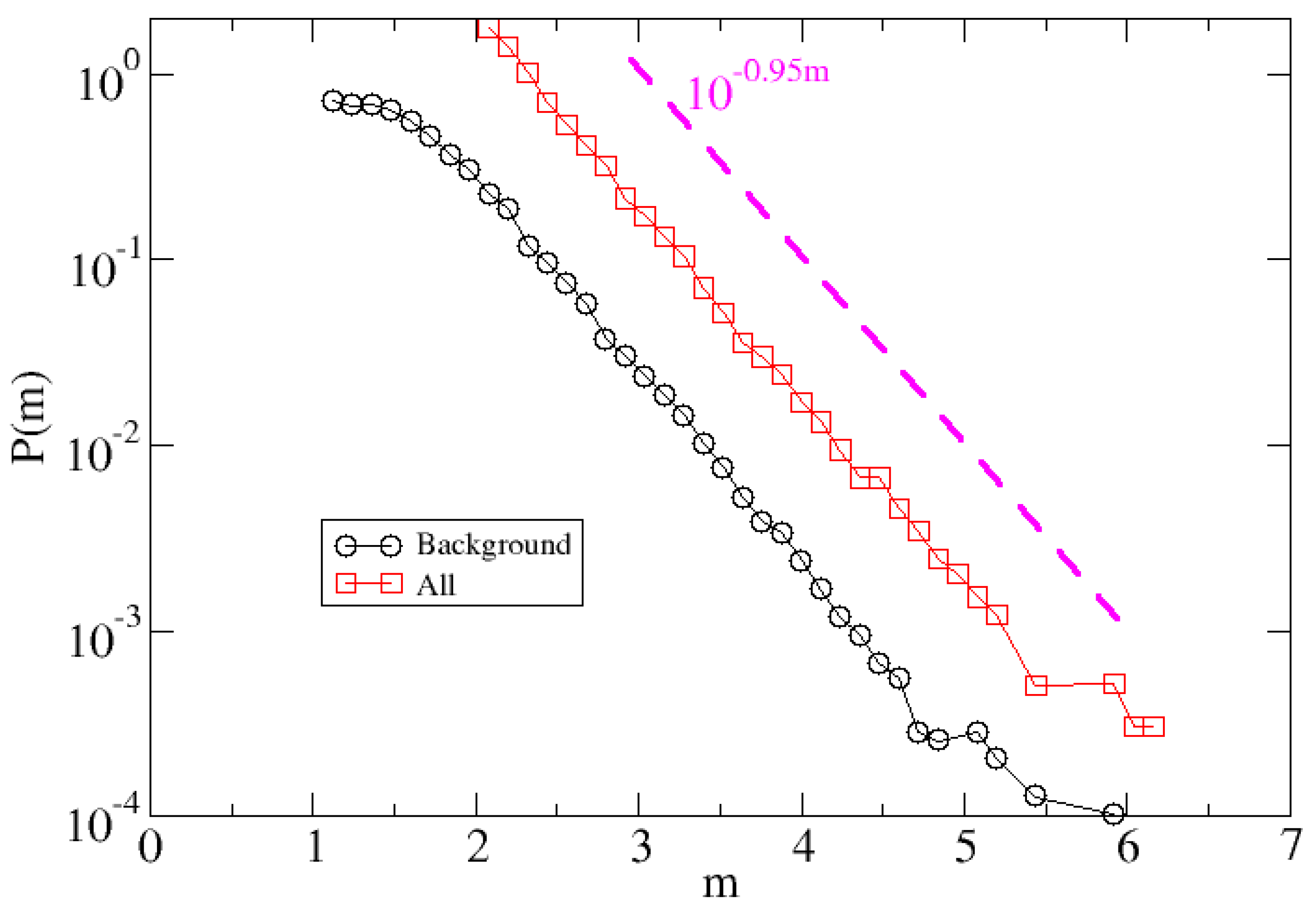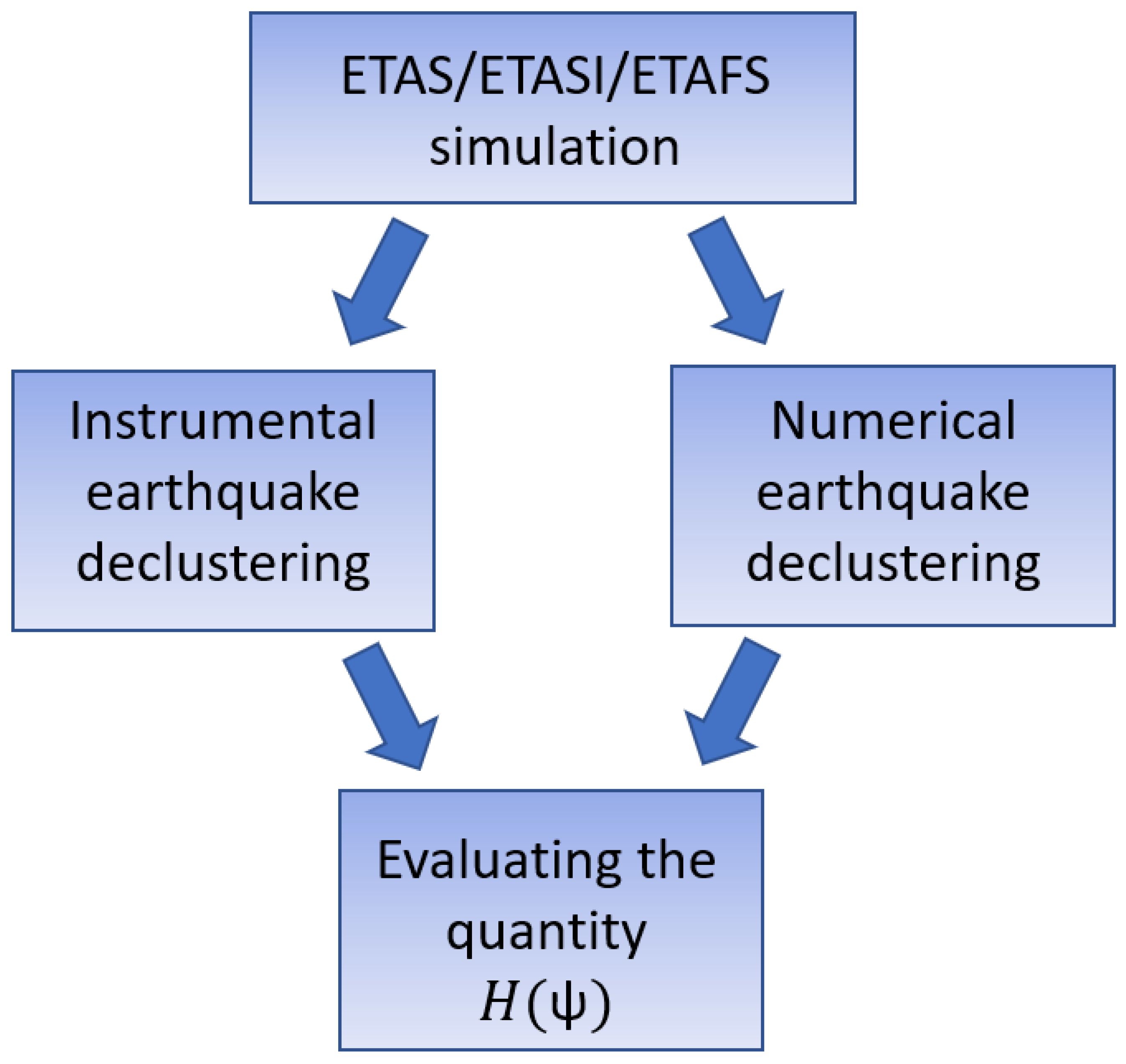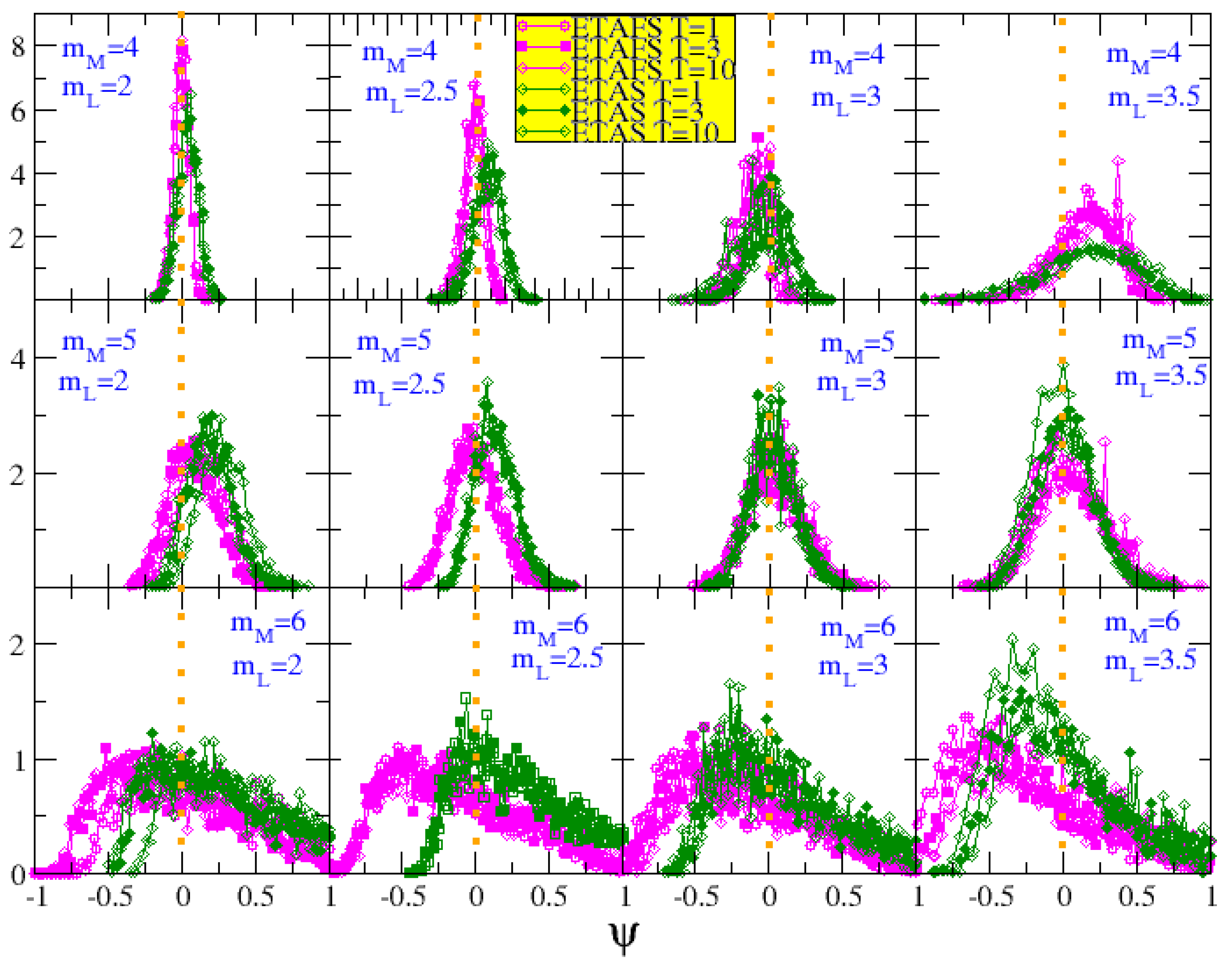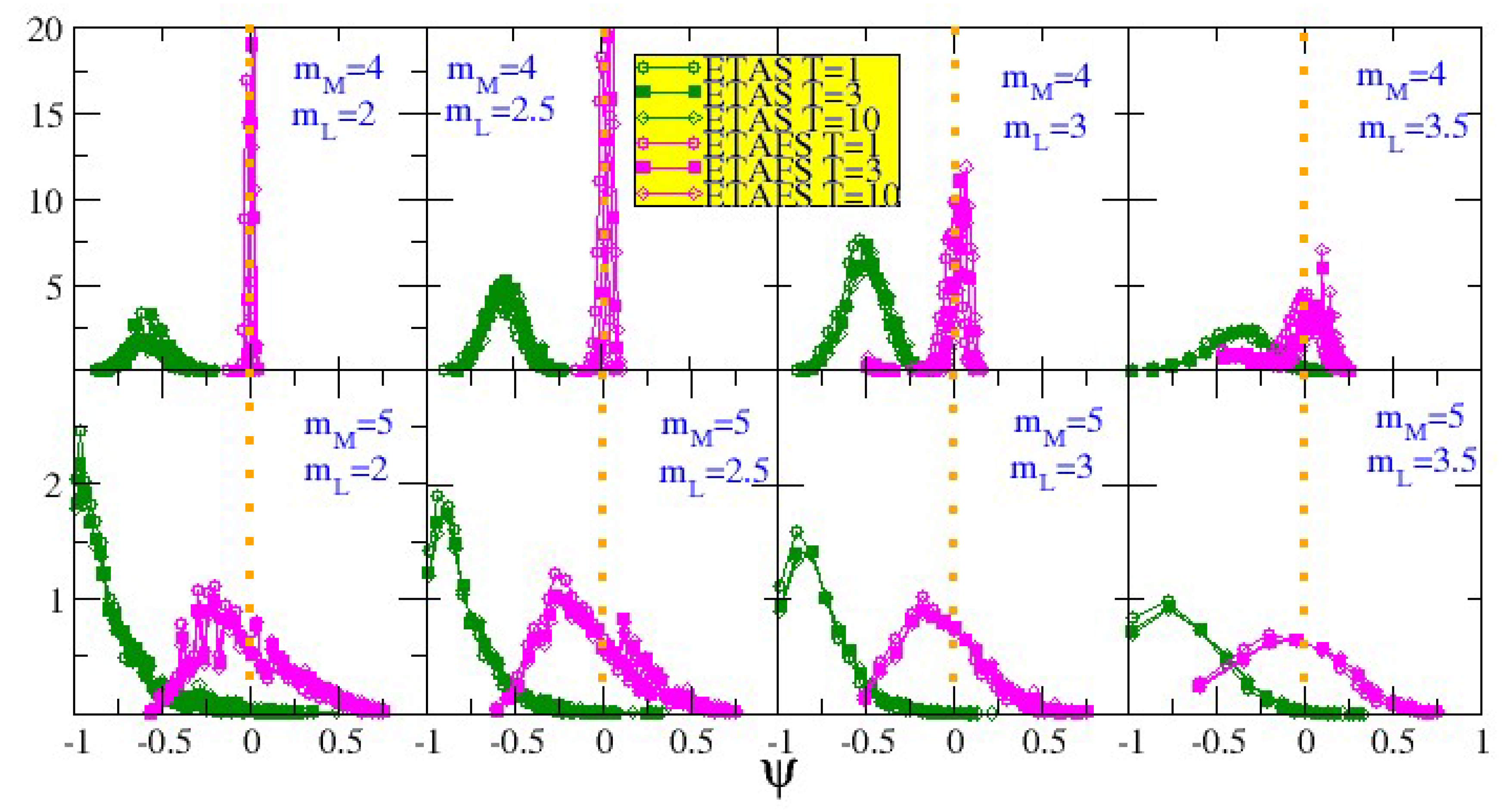Incorporating Foreshocks in an Epidemic-like Description of Seismic Occurrence in Italy
Abstract
:1. Introduction
2. General Definitions and Declustering
Aftershock, Foreshocks and Declustering Techniques
3. The Models
3.1. The Fixed- ETAS Model
3.2. The Incomplete ETAS Model: The ETASI Model
3.3. The Top-Down Loading ETAS Model—The ETAFS Model
4. Data Catalog, Methods and Null Models
5. Results
5.1. Aftershock Comparison
5.2. Foreshock Comparison
Foreshocks for Mainshocks with
6. Conclusions
Author Contributions
Funding
Data Availability Statement
Acknowledgments
Conflicts of Interest
References
- Ogata, Y. Statistical Models for Earthquake Occurrences and Residual Analysis for Point Processes. J. Am. Stat. Assoc. 1988, 83, 9–27. [Google Scholar] [CrossRef]
- Ogata, Y. Space-time point-process models for earthquake occurrences. Ann. Inst. Stat. Math. 1998, 50, 379–402. [Google Scholar] [CrossRef]
- Petrillo, G.; Zhuang, J. Bayesian Earthquake Forecasting approach based on the Epidemic Type Aftershock Sequence model. Res. Sq. 2022. [Google Scholar] [CrossRef]
- Zhuang, J. Next-day earthquake forecasts for the Japan region generated by the ETAS model. Earth Planets Space 2011, 63, 207–216. [Google Scholar] [CrossRef] [Green Version]
- Zhuang, J. Long-term earthquake forecasts based on the epidemic-type aftershock sequence (ETAS) model for short-term clustering. Res. Geophys. 2012, 2, e8. [Google Scholar] [CrossRef] [Green Version]
- Mignan, A. The debate on the prognostic value of earthquake foreshocks: A meta-analysis. Sci. Rep. 2014, 4, 4099. [Google Scholar] [CrossRef] [Green Version]
- Mignan, A. Seismicity precursors to large earthquakes unified in a stress accumulation framework. Geophys. Res. Lett. 2012, 39, 21308. [Google Scholar] [CrossRef]
- Das, S.; Scholz, C. Theory of time-dependent rupture in the Earth. J. Geophys. Res. Solid Earth 1981, 86, 6039–6051. [Google Scholar] [CrossRef] [Green Version]
- Helmstetter, A.; Sornette, D. Foreshocks explained by cascades of triggered seismicity. J. Geophys. Res. Solid Earth 2003, 108, 457. [Google Scholar] [CrossRef] [Green Version]
- Helmstetter, A.; Sornette, D.; Grasso, J. Mainshocks are aftershocks of conditional foreshocks: How do foreshock statistical properties emerge from aftershock laws. J. Geophys. Res. Solid Earth 2003, 108, 2046. [Google Scholar] [CrossRef] [Green Version]
- Felzer, K.R.; Abercrombie, R.E.; Ekstrm, G. A Common Origin for Aftershocks, Foreshocks, and Multiplets. Bull. Seismol. Soc. Am. 2004, 94, 88–98. [Google Scholar] [CrossRef]
- Hardebeck, J.; Felzer, K.; Michael, A. Improved tests reveal that the accelerating moment release hypothesis is statistically insignificant. J. Geophys. Res. 2008, 113, B08310. [Google Scholar]
- Marzocchi, W.; Zhuang, J. Statistics between mainshocks and foreshocks in Italy and Southern California. Geophys. Res. Lett. 2011, 38, L09310. [Google Scholar] [CrossRef]
- Brodsky, E.E. The spatial density of foreshocks. Geophys. Res. Lett. 2011, 38, L10305. [Google Scholar] [CrossRef] [Green Version]
- Lippiello, E.; Marzocchi, W.; de Arcangelis, L.; Godano, C. Spatial organization of foreshocks as a tool to forecast large earthquakes. Sci. Rep. 2012, 2, 1–6. [Google Scholar] [CrossRef] [Green Version]
- Shearer, P.M. Self-similar earthquake triggering, Båth’s law, and foreshock/aftershock magnitudes: Simulations, theory, and results for southern California. J. Geophys. Res. Solid Earth 2012, 117, B06310. [Google Scholar] [CrossRef]
- Ogata, Y.; Katsura, K. Comparing foreshock characteristics and foreshock forecasting in observed and simulated earthquake catalogs. J. Geophys. Res. Solid Earth 2014, 119, 8457–8477. [Google Scholar] [CrossRef]
- de Arcangelis, L.; Godano, C.; Grasso, J.R.; Lippiello, E. Statistical physics approach to earthquake occurrence and forecasting. Phys. Rep. 2016, 628, 1–91. [Google Scholar]
- Seif, S.; Zechar, J.D.; Mignan, A.; Nandan, S.; Wiemer, S. Foreshocks and Their Potential Deviation from General Seismicity. Bull. Seismol. Soc. Am. 2018, 109, 1–18. [Google Scholar] [CrossRef]
- Trugman, D.T.; Ross, Z.E. Pervasive Foreshock Activity Across Southern California. Geophys. Res. Lett. 2019, 46, 8772–8781. [Google Scholar] [CrossRef] [Green Version]
- Petrillo, G.; Lippiello, E. Testing of the foreshock hypothesis within an epidemic like description of seismicity. Geophys. J. Int. 2020, 225, 1236–1257. [Google Scholar] [CrossRef]
- Landes, F.P. Viscoelastic interfaces driven in disordered media. In Viscoelastic Interfaces Driven in Disordered Media; Springer Theses: New York, NY, USA, 2016; pp. 113–166. [Google Scholar]
- Jagla, E.A.; Landes, F.P.; Rosso, A. Viscoelastic effects in avalanche dynamics: A key to earthquake statistics. Phys. Rev. Lett. 2014, 112, 174301. [Google Scholar] [PubMed] [Green Version]
- Lippiello, E.; Petrillo, G.; Landes, F.; Rosso, A. Fault Heterogeneity and the Connection between Aftershocks and Afterslip. Bull. Seismol. Soc. Am. 2019, 109, 1156–1163. [Google Scholar]
- Petrillo, G.; Landes, F.P.; Lippiello, E.; Rosso, A. The influence of the brittle-ductile transition zone on aftershock and foreshock occurrence. Nat. Commun. 2020, 11, 3010. [Google Scholar] [PubMed]
- Lippiello, E.; Petrillo, G.; Landes, F.; Rosso, A. The Genesis of Aftershocks in Spring Slider Models. Stat. Methods Model. Seism. 2021, 1, 131–151. [Google Scholar]
- Petrillo, G.; Rosso, A.; Lippiello, E. Testing of the Seismic Gap Hypothesis in a Model With Realistic Earthquake Statistics. J. Geophys. Res. Solid Earth 2022, 127, e2021JB023542. [Google Scholar] [CrossRef]
- Burridge, R.; Knopoff, L. Model and theoretical seismicity. Bullettin Seismol. Soc. Am. 1967, 341–371. [Google Scholar] [CrossRef]
- Olami, Z.; Feder, H.J.S.; Christensen, K. Self-organized criticality in a continuous, nonconservative cellular automaton modeling earthquakes. Phys. Rev. Lett. 1992, 68, 1244–1247. [Google Scholar]
- de Arcangelis, L.; Godano, C.; Lippiello, E. The Overlap of Aftershock Coda Waves and Short-Term Postseismic Forecasting. J. Geophys. Res. Solid Earth 2018, 123, 5661–5674. [Google Scholar] [CrossRef]
- Hainzl, S. ETAS-Approach Accounting for Short-Term Incompleteness of Earthquake Catalogs. Bull. Seismol. Soc. Am. 2022, 112, 494–507. [Google Scholar]
- Baiesi, M.; Paczuski, M. Scale-free networks of earthquakes and aftershocks. Phys. Rev. E 2004, 69, 066106. [Google Scholar] [CrossRef] [Green Version]
- Baiesi, M.; Paczuski, M. Complex networks of earthquakes and aftershocks. Nonlinear Process. Geophys. 2005, 12. [Google Scholar] [CrossRef]
- Zaliapin, I.; Gabrielov, A.; Keilis-Borok, V.; Wong, H. Clustering Analysis of Seismicity and Aftershock Identification. Phys. Rev. Lett. 2008, 101, 018501. [Google Scholar] [PubMed] [Green Version]
- Zaliapin, I.; Ben-Zion, Y. Earthquake clusters in southern California I: Identification and stability. J. Geophys. Res. Solid Earth 2013, 118, 2847–2864. [Google Scholar] [CrossRef]
- Seif, S.; Mignan, A.; Zechar, J.D.; Werner, M.J.; Wiemer, S. Estimating ETAS: The effects of truncation, missing data, and model assumptions. J. Geophys. Res. Solid Earth 2017, 122, 449–469. [Google Scholar] [CrossRef] [Green Version]
- Helmstetter, A.; Kagan, Y.Y.; Jackson, D.D. Importance of small earthquakes for stress transfers and earthquake triggering. J. Geophys. Res. Solid Earth 2005, 110, B05S08. [Google Scholar] [CrossRef] [Green Version]
- Hainzl, S.; Christophersen, A.; Enescu, B. Impact of Earthquake Rupture Extensions on Parameter Estimations of Point-Process Models. Bull. Seismol. Soc. Am. 2008, 98, 2066–2072. [Google Scholar] [CrossRef]
- Kagan, Y.Y. Short-Term Properties of Earthquake Catalogs and Models of Earthquake Source. Bull. Seismol. Soc. Am. 2004, 94, 1207–1228. [Google Scholar] [CrossRef] [Green Version]
- Helmstetter, A.; Kagan, Y.Y.; Jackson, D.D. Comparison of Short-Term and Time-Independent Earthquake Forecast Models for Southern California. Bull. Seismol. Soc. Am. 2006, 96, 90–106. [Google Scholar] [CrossRef] [Green Version]
- Enescu, B.; Mori, J.; Miyazawa, M. Quantifying early aftershock activity of the 2004 mid-Niigata Prefecture earthquake (Mw6.6). J. Geophys. Res. Solid Earth 2007, 112. [Google Scholar] [CrossRef] [Green Version]
- Peng, Z.; Vidale, J.E.; Ishii, M.; Helmstetter, A. Seismicity rate immediately before and after main shock rupture from high-frequency waveforms in Japan. J. Geophys. Res. Solid Earth 2007, 112, B03306. [Google Scholar] [CrossRef] [Green Version]
- Peng, Z.; Zhao, P. Migration of early aftershocks following the 2004 Parkfield earthquake. Nat. Geosci. 2009, 2, 877–881. [Google Scholar] [CrossRef]
- Lippiello, E.; Cirillo, A.; Godano, G.; Papadimitriou, E.; Karakostas, V. Real-time forecast of aftershocks from a single seismic station signal. Geophys. Res. Lett. 2016, 43, 6252–6258. [Google Scholar] [CrossRef]
- Hainzl, S. Apparent triggering function of aftershocks resulting from rate-dependent incompleteness of earthquake catalogs. J. Geophys. Res. Solid Earth 2016, 121, 6499–6509. [Google Scholar] [CrossRef] [Green Version]
- Hainzl, S. Rate-Dependent Incompleteness of Earthquake Catalogs. Seismol. Res. Lett. 2016, 87, 337–344. [Google Scholar]
- Lippiello, E.; Giacco, F.; Marzocchi, W.; Godano, G.; Arcangelis, L.D. Statistical features of foreshocks in instrumental and ETAS catalogs. Pure Appl. Geophys. 2017, 174, 1679–1697. [Google Scholar] [CrossRef]
- Lippiello, E.; Godano, C.; de Arcangelis, L. The Relevance of Foreshocks in Earthquake Triggering: A Statistical Study. Entropy 2019, 21, 173. [Google Scholar] [CrossRef] [Green Version]
- Lippiello, E.; Petrillo, G.; Godano, C.; Papadimitriou, E.; Karakostas, V. Forecasting of the first hour aftershocks by means of the perceived magnitude. Nat. Commun. 2019, 10, 2953. [Google Scholar] [CrossRef] [Green Version]
- Utsu, T.; Ogata, Y.; Matsuura, R. The centenary of the Omori formula for a decay law of aftershock activity. J. Phys. Earth 1995, 43, 1–33. [Google Scholar]
- Petrillo, G.; Zhuang, J. The debate on the earthquake magnitude correlations: A meta-analysis. Sci. Rep. 2022, 12, 20683. [Google Scholar]





| Model | b | p | c | d | q | |||||||
|---|---|---|---|---|---|---|---|---|---|---|---|---|
| ETAS | 0.07 | 0.95 | 0.95 | 1.2 | 0.024 | 0.006 | 1.958 | 1.3 | - | - | - | - |
| ETASI | 0.1 | 0.93 | 0.95 | 1.2 | 0.01 | 0.006 | 1.958 | 1.3 | 0.3 | 1 | - | - |
| ETAFS | 0.1 | 0.93 | 0.95 | 1.2 | 0.01 | 0.006 | 1.958 | 1.3 | 0.3 | 1 | 0.05 | 0.5 |
| 4 | 2 | 1 | 0 | 0 | 0.6 |
| 4 | 2 | 3 | 0 | 0.01 | 0.73 |
| 4 | 2 | 10 | 0 | 0.02 | 0.76 |
| 4 | 2.5 | 1 | 0 | 0 | 0.50 |
| 4 | 2.5 | 3 | 0 | 0 | 0.8 |
| 4 | 2.5 | 10 | 0 | 0.01 | 0.85 |
| 4 | 3 | 1 | 0 | 0.01 | 0.43 |
| 4 | 3 | 3 | 0 | 0.03 | 0.80 |
| 4 | 3 | 10 | 0 | 0.05 | 0.92 |
| 4 | 3.5 | 1 | 0 | 0.10 | 0.30 |
| 4 | 3.5 | 3 | 0.02 | 0.10 | 0.51 |
| 4 | 3.5 | 10 | 0.03 | 0.15 | 0.58 |
| 5 | 2 | 1 | 0 | 0.03 | 0.32 |
| 5 | 2 | 3 | 0.01 | 0.05 | 0.39 |
| 5 | 2 | 10 | 0.02 | 0.07 | 0.42 |
| 5 | 2.5 | 1 | 0 | 0.01 | 0.29 |
| 5 | 2.5 | 3 | 0 | 0.03 | 0.37 |
| 5 | 2.5 | 10 | 0 | 0.05 | 0.40 |
| 5 | 3 | 1 | 0 | 0.01 | 0.28 |
| 5 | 3 | 3 | 0 | 0.03 | 0.34 |
| 5 | 3 | 10 | 0 | 0.05 | 0.37 |
| 5 | 3.5 | 1 | 0.01 | 0.16 | 0.22 |
| 5 | 3.5 | 3 | 0.03 | 0.26 | 0.27 |
| 5 | 3.5 | 10 | 0.04 | 0.33 | 0.29 |
| Name | Mw | Date |
|---|---|---|
| L’Aquila | 6.0 | 6 April 2009 |
| Amatrice | 6.0 | 24 August 2016 |
| Norcia | 6.5 | 30 October 2016 |
Disclaimer/Publisher’s Note: The statements, opinions and data contained in all publications are solely those of the individual author(s) and contributor(s) and not of MDPI and/or the editor(s). MDPI and/or the editor(s) disclaim responsibility for any injury to people or property resulting from any ideas, methods, instructions or products referred to in the content. |
© 2023 by the authors. Licensee MDPI, Basel, Switzerland. This article is an open access article distributed under the terms and conditions of the Creative Commons Attribution (CC BY) license (https://creativecommons.org/licenses/by/4.0/).
Share and Cite
Petrillo, G.; Lippiello, E. Incorporating Foreshocks in an Epidemic-like Description of Seismic Occurrence in Italy. Appl. Sci. 2023, 13, 4891. https://doi.org/10.3390/app13084891
Petrillo G, Lippiello E. Incorporating Foreshocks in an Epidemic-like Description of Seismic Occurrence in Italy. Applied Sciences. 2023; 13(8):4891. https://doi.org/10.3390/app13084891
Chicago/Turabian StylePetrillo, Giuseppe, and Eugenio Lippiello. 2023. "Incorporating Foreshocks in an Epidemic-like Description of Seismic Occurrence in Italy" Applied Sciences 13, no. 8: 4891. https://doi.org/10.3390/app13084891





